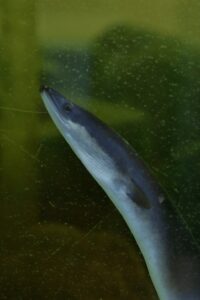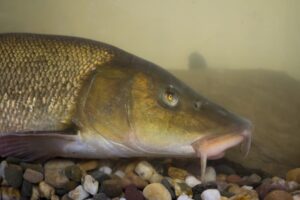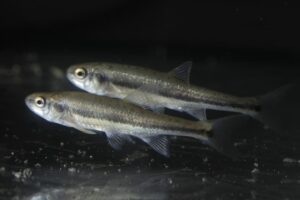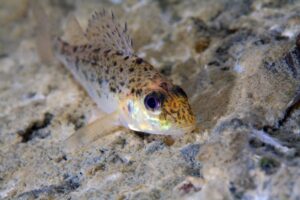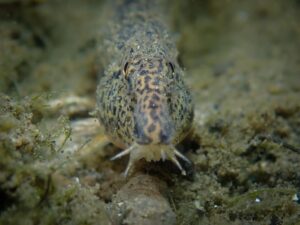Coarse fish: Stone Moroko (Pseudorasbora parva)
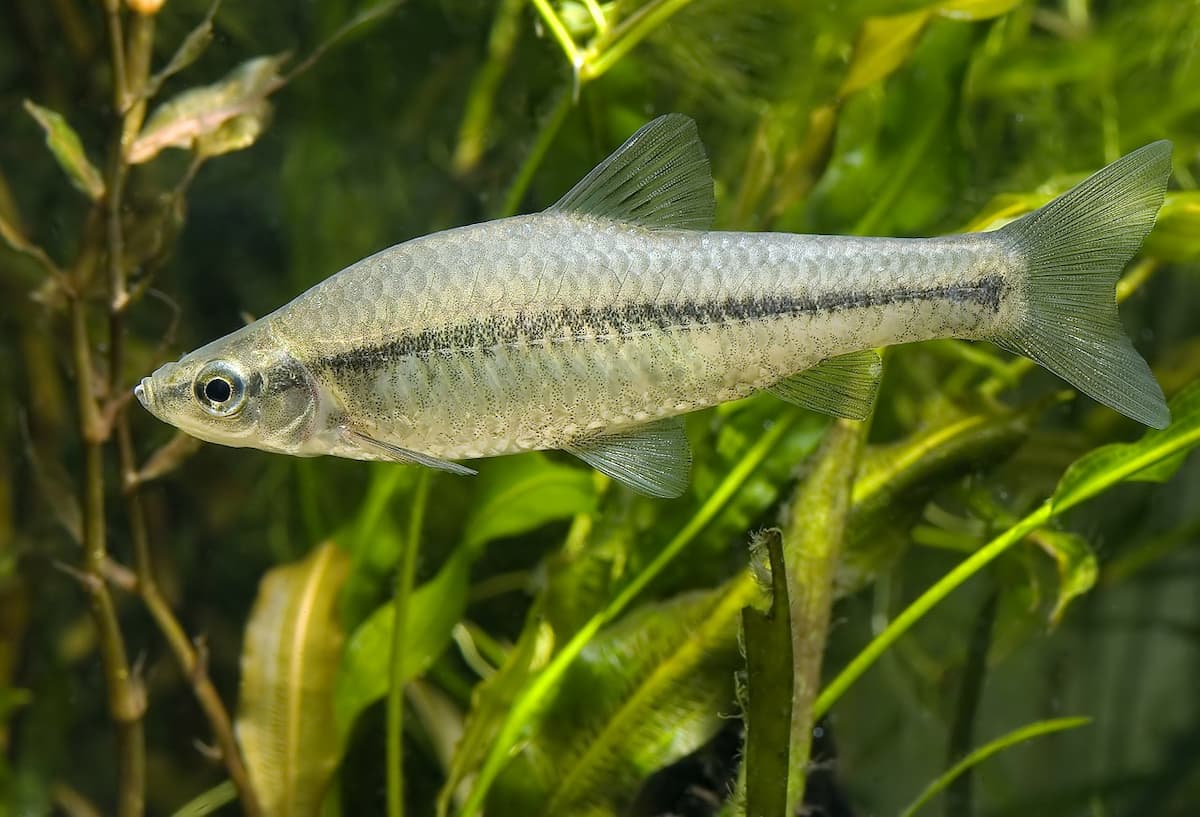
The Stone Moroko (Pseudorasbora parva), a freshwater fish native to East Asia, has established its presence in Europe, where it is regarded as an invasive species, posing ecological challenges to native aquatic ecosystems.
This species’ introduction to European waters has been attributed to various factors, including unintentional release from aquaculture and the ornamental fish trade. The Stone Moroko’s adaptability and high reproductive rate have enabled it to thrive in diverse European water bodies, from small ponds to larger rivers.
Its presence in these new habitats has significant ecological implications. The Stone Moroko (Pseudorasbora parva) competes with native fish species for food and habitat, often leading to declining local biodiversity. Additionally, it can disrupt the natural balance of aquatic ecosystems by preying on or outcompeting native species, mainly juvenile fish and invertebrates.
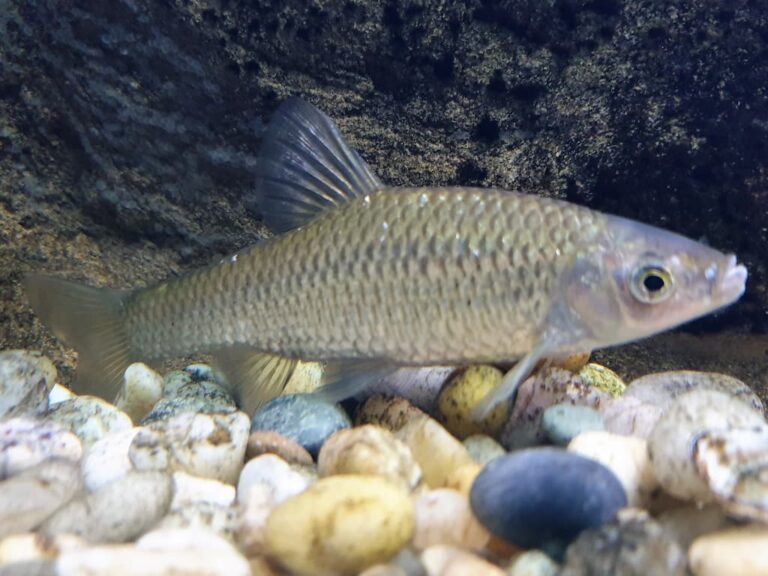
What is a Stone moroko (Pseudorasbora parva)?
The Stone moroko (Pseudorasbora parva) is a small freshwater fish native to East Asia. It has a slender body with silvery colouration and a slightly forked tail. The head is small with a terminal mouth, and the fins are generally clear or pale. This species can grow up to 10 centimetres in length and typically weighs around 10 grams. Stone moroko have a relatively short lifespan, usually about 3 to 4 years. They are commonly found in slow-moving or stagnant waters such as ponds, lakes, and canals, and are known to be omnivorous, feeding on a variety of small invertebrates and plant matter.
Physical Description
Characterisation
The Stone Moroko has an elongated, somewhat cylindrical body, contributing to its streamlined appearance. Additionally, the body is covered in small scales, and the colouration can vary from silver to olive green on the back, fading to a lighter shade on the belly.
The head is relatively small and pointed, with a terminal mouth and a slightly upturned snout, meaning the mouth is located at the end of the snout.
The dorsal fin is short and rounded, typically with a light base and a darker tip. The caudal fin is forked, aiding in swift movements, and the pelvic and anal fins are small and unobtrusive. The fins are generally translucent with a tint of red or orange.
The pigmentation of these fish species is distinctive, with a dark crescent on the back edge of the scales and a prominent brown band on the sides, particularly in younger individuals.
| Class |
| Actinopterygii |
| Order |
| Cypriniformes |
| Family |
| Cyprinidae |
| Genus |
| Pseudorasbora |
| Species |
| P. parva |
| Binomial Name |
| Pseudorasbora parva (Temminck & Schlegel, 1846) |
Size and Weight
The Stone Moroko is a small species, usually measuring about 5 to 8 centimetres (2 to 3 inches) in length and weighing proportionally to its size.
Lifespan
In natural conditions, the Stone Moroko has a lifespan of around 3 to 5 years.
Habitat and Distribution
This species prefers slow-moving or stagnant waters, such as ponds, lakes, and slow-flowing rivers. It is known for its ability to thrive in various water conditions, including slightly brackish environments. Moreover, the Stone Moroko is native to East Asia, specifically in countries such as China, Japan, Korea, and Russia. It has also been introduced to various European countries, including the United Kingdom, where it is considered an invasive species.
Feeding Habits
The Stone Moroko is an omnivorous species that feeds on various small invertebrates, algae, and plant matter. Its diet adapts to the availability of food sources in its environment. It is known to consume the eggs of other fish species, making it a potential threat to native fish populations. Due to its invasive behaviour, the Stone Moroko has been listed as a species of concern in some regions.
Reproduction
Reproduction occurs mainly in spring and early summer. Females lay eggs in shallow waters among vegetation, where the males fertilise them. The species is known for its high reproductive rate, contributing to its invasive potential in non-native environments.
Fishing Interest and Technique
The Stone Moroko is of limited interest to anglers, as it is a small species not typically targeted for sport or commercial fishing. However, in some regions where it is considered invasive, efforts may be made to control its population through fishing. The fishing technique for catching Stone Moroko is similar to that of other small freshwater fish, using small hooks and bait such as worms or insects.
International Common Names
Due to its wide distribution across different regions, the Stone Moroko, also known as the Topmouth Gudgeon and Amur bitterling, is internationally recognised by various common names. It is also called the Pond Loach and the Japanese Stone Moroko in other parts of the world. Moreover, it is known as Blauwband in Dutch, Pseudorasbora in French and Italian, Blaubandbärbling in German, and Czebaczek amurski in Polish.
Invasive Behavior and Threat on Other Species
Since 2016, Pseudoboras parva has been listed as an Invasive Alien Species of Union concern in Europe, prohibiting its importation, breeding, transportation, commercialisation, or intentional release within the European Union.
The fish was initially introduced in the 1960s in Nucet, Dâmbovița County, Romania, and subsequently spread to the Danube and throughout Europe. By feeding on their eggs, these fish threaten local native fish species.
Pseudorasbora parva also poses a threat to other species, such as the Sunbleaks (Leucaspius delineatus), as carriers of the parasite Sphaerothecum destruens, which is harmful to other fishes but not to the Pseudoboras. In addition to these co-introduced parasites, the fish was found to be infected with a local generalist, the monogenean Gyrodactylus prostae. Infections of monogeneans were generally lower in non-native host fish, potentially providing an advantage to this invasive species.
Conservation Status on the IUCN Red List
The Stone Moroko Pseudorasbora parva is currently listed as a species of Least Concern on the IUCN Red List. While it is considered an invasive species in some regions, its population is stable, and it does not face significant threats that would warrant a higher conservation status. However, monitoring and managing its population in non-native environments are essential to prevent further negative impacts on local ecosystems and native species. Efforts to control its spread and prevent other introductions in new areas are also necessary to conserve native biodiversity.

